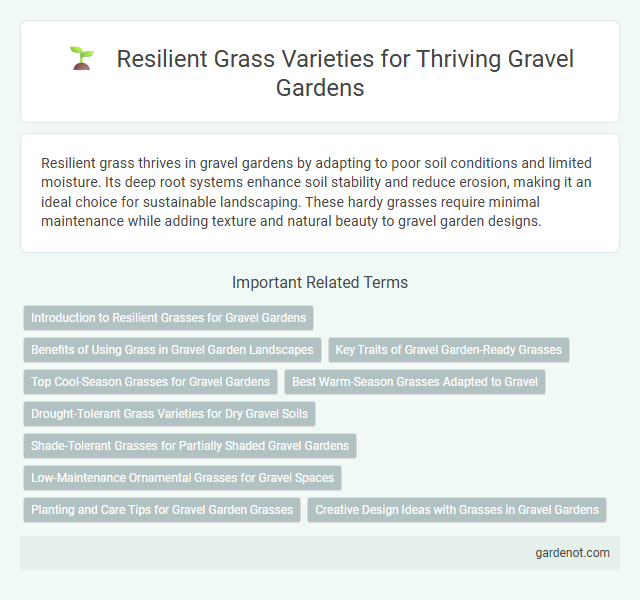Resilient grass thrives in gravel gardens by adapting to poor soil conditions and limited moisture. Its deep root systems enhance soil stability and reduce erosion, making it an ideal choice for sustainable landscaping. These hardy grasses require minimal maintenance while adding texture and natural beauty to gravel garden designs.
Introduction to Resilient Grasses for Gravel Gardens
Resilient grasses such as Festuca glauca, blue fescue, and Carex oshimensis thrive in gravel gardens due to their drought tolerance, low maintenance, and ability to withstand poor soil conditions. These grasses contribute texture and movement, enhancing the aesthetic appeal while requiring minimal water and fertilizer. Selecting species like Pennisetum alopecuroides promotes sustainability and durability in gravel garden landscapes.
Benefits of Using Grass in Gravel Garden Landscapes
Resilient grass in gravel garden landscapes enhances soil stability by preventing erosion and improving water drainage. It provides a natural, low-maintenance ground cover that reduces weed growth and supports local biodiversity by attracting pollinators. Utilizing drought-tolerant grass varieties further minimizes water consumption, making gravel gardens both sustainable and visually appealing.
Key Traits of Gravel Garden-Ready Grasses
Gravel garden-ready grasses exhibit exceptional drought tolerance, robust root systems, and low maintenance needs, making them ideal for water-scarce environments. These resilient grasses thrive in poor, well-drained soils and withstand heat stress while preventing soil erosion. Their compact growth habit and deep roots enhance durability and sustainability in gravel garden landscapes.
Top Cool-Season Grasses for Gravel Gardens
Kentucky bluegrass, fine fescues, and perennial ryegrass are top cool-season grasses ideal for gravel gardens due to their resilience and adaptability to poor soil conditions. Fine fescues thrive in low-nutrient, dry environments, making them perfect for maintaining green coverage in gravel-based landscapes. Kentucky bluegrass offers dense turf development and wear tolerance, ensuring durability and aesthetic appeal in gravel garden settings.
Best Warm-Season Grasses Adapted to Gravel
Buffalo grass (Bouteloua dactyloides) and Bermuda grass (Cynodon dactylon) are exceptional warm-season grasses that thrive in gravel garden settings due to their drought tolerance and low maintenance needs. Zoysia grass (Zoysia japonica) offers a dense, resilient turf that can withstand heat and compacted soils commonly found in gravel landscapes. These grasses optimize soil retention and reduce erosion, making them ideal choices for sustainable gravel garden designs.
Drought-Tolerant Grass Varieties for Dry Gravel Soils
Drought-tolerant grass varieties such as Buffalo Grass, Bermuda Grass, and Zoysia Grass thrive in dry gravel soils, offering exceptional resilience and low water requirements. These grasses develop deep root systems that efficiently access limited moisture, making them ideal for gravel gardens in arid climates. Selecting resilient species reduces irrigation needs and promotes sustainable landscaping in challenging, well-drained gravel environments.
Shade-Tolerant Grasses for Partially Shaded Gravel Gardens
Shade-tolerant grasses like Festuca ovina and Carex appressa thrive in partially shaded gravel gardens, providing resilience and low maintenance. These grasses adapt well to the filtered sunlight and poor soil conditions typical of gravel settings, ensuring year-round greenery and texture. Their drought resistance and ability to withstand foot traffic make them ideal for sustainable, visually appealing garden designs.
Low-Maintenance Ornamental Grasses for Gravel Spaces
Low-maintenance ornamental grasses such as Festuca glauca and Carex oshimensis thrive in gravel gardens, offering resilience and year-round texture without frequent watering. These drought-tolerant species adapt well to well-drained, rocky soils, reducing the need for fertilizers and mowing. Their compact growth habits minimize debris, making them ideal for sustaining clean, visually appealing gravel landscapes.
Planting and Care Tips for Gravel Garden Grasses
Choosing resilient grass species like Festuca glauca or Carex pansa enhances durability in gravel gardens, thriving in well-drained, nutrient-poor soils. Plant grasses in spring or early fall to establish strong root systems, ensuring regular watering during initial growth phases without waterlogging. Mulching with gravel helps retain moisture and suppress weeds, while periodic trimming maintains aesthetic appeal and prevents overgrowth.
Creative Design Ideas with Grasses in Gravel Gardens
Resilient grass varieties like Festuca glauca and Deschampsia cespitosa thrive in gravel gardens, offering texture and movement while requiring minimal water and maintenance. Incorporating clumps of ornamental grasses alongside gravel pathways creates striking contrasts between soft foliage and hard surfaces, enhancing garden depth and visual interest. Strategic grouping and varying grass heights enable dynamic layers that improve both aesthetic appeal and environmental sustainability in gravel garden designs.
Resilient grass Infographic

 gardenot.com
gardenot.com